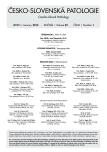Dysplázie sliznice žaludku.
Klinickopatologická studie 35 případů
:
Alena Chlumská 1,2; Petr Mukenšnabl 1; Tomáš Waloschek 2; Michal Zámečník 3
:
Šikl`s Department of Pathology, Medical Faculty Hospital, Charles University, Pilsen, Czech Republic
1; Laboratory of Surgical Pathology, Pilsen, Czech Republic
2; Medicyt s. r. o., Department of Pathology, Trenčín, Slovak Republic
3
:
Čes.-slov. Patol., 49, 2013, No. 1, p. 35-38
:
Original Article
Dysplázie žaludeční sliznice je všeobecně uznávaným prekurzorem adenokarcinomu žaludku. Podle typu produkovaných hlenů a buněčné diferenciace se v poslední době rozlišují tři základní typy dysplastických změn: adenomatózní (intestinální), foveolární (gastrický) a hybridní (smíšený). Naší sestavu tvoří 35 nemocných (21 mužů a 14 žen, prům. věk 69,9 let) s biopticky ověřenou dysplázií žaludeční sliznice. Adenomatózní dysplázie se vyskytovala u 17 nemocných (49 %) a většinou odpovídala low grade lézi (n = 14). Foveolární typ byl prokázán u 16 nemocných (46 %); téměř v polovině případů se jednalo o high grade dysplázii (n = 7). U jedné nemocné se low grade foveolární dysplázie nacházela v polypózním prolapsu antrální sliznice žaludku. Hybridní dysplázie byla prokázána pouze u dvou případů (0,6 %), v jednom případě low-grade a v druhém high-grade typu. Dysplastické změny byly převážně lokalizované v antrální části žaludku. V okolní sliznici odpovídal nález u většiny nemocných Helicobacter pylori negativní chronické neaktivní gastritidě s kompletní nebo nekompletní intestinální metaplazií. Nálezy v naší sestavě nemocných prokázaly vyšší výskyt foveolární dysplázie, než se všeobecně uvádí. Ve shodě s předchozími studiemi měla foveolární dysplázie častěji charakter high-grade léze.
Klíčová slova:
žaludek – dysplázie – imunohistochemie – low-grade – high-grade
Sources
1. Lauwers GY, Riddell RH. Gastric epithelial dysplasia. Gut 1999; 45(5): 784–790.
2. Misdraji J, Lauwers GY. Gastric epithelial dysplasia. Semin Diagn Pathol 2002; 19(1): 20–30.
3. Rugge M, Farinati F, Baffa R, et al. Gastric epithelial dysplasia in the natural history of gastric cancer: a multicenter prospective follow-up study. Gastroenterology 1994; 107(5): 1288 –1296.
4. Shin N, Jo HJ, Kim WK, et al. Gastric pit dysplasia in adjacent gastric mucosa in 414 gastric cancers: prevalence and characteristics. Am J Surg Pathol 2011; 35(7): 1021–1029.
5. Bosman FT. World Health Organization; International Agency for Research on Cancer. WHO classification of tumours of the digestive system. 4th ed., Lyon, IARC Press, 2010.
6. Abraham SC, Montgomery EA, Singh VK, et al. Gastric adenomas. Intestinal-type and gastric-type adenomas differ in the risk of adenocarcinoma and presence of background mucosal pathology. Am J Surg Pathol 2002; 26(10): 1276–1285.
7. Lauwers GY. Defining the pathologic diagnosis of metaplasia, atrophy, dysplasia, and gastric adenocarcinoma. J Clin Gastroenterol 2003; 36(Suppl. 1): S37–S43.
8. Abraham SC, Park SJ, Lee JH, et al. Genetic alterations in gastric adenomas of intestinal and foveolar phenotypes. Mod Pathol 2003; 16(8): 786–795.
9. Alfaro EE, Lauwers GY. Early gastric neoplasia: diagnosis and implications. Adv Anat Pathol 2011; 18(4): 268–280.
10. Park DY, Srivastava A, Kim GH, et al. Adenomatous and foveolar gastric dysplasia: distinct patterns of mucin expression and background intestinal metaplasia. Am J Surg Pathol 2008; 32(4): 524–533.
11. Rugge M, Correa P, Dixon MF, et al. Gastric dysplasia: the Padova international classification. Am J Surg Pathol 2000; 24(2): 167–176.
12. Chlumská A, Mukenšnabl P, Waloschek T, Zámečník M. Dysplázie žaludku. Kongresové noviny, No 2, p. 5, 32nd Meeting of Czech and Slovak Gastroenterologist, Nov 3–5, 2011, Brno, Czech Republic.
13. Srivastava A, Lauwers GY. Gastric epithelial dysplasia: the Western perspective. Dig Liver Dis 2008; 40(8): 641–649.
14. Mahajan D, Bennett AE, Liu X, et al. Grading of gastric foveolar-type dysplasia in Barrett’s esophagus. Mod Pathol 2010; 23(1): 1–11.
15. Khor TS, Alfaro EE, Ooi EMM, et al. Divergent expression of MUC5AC, MUC6, MUC2, CD10, and CDX2 in dysplasia and intramucosal adenocarcinomas with intestinal and foveolar morphology: is this evidence of distinct gastric and intestinal pathways to carcinogenesis in Barrett esophagus? Am J Surg Pathol 2012; 36(3): 331–342.
16. Farinati F, Rugge M, Di Mario F, et al. Early and advanced gastric cancer in the follow-up of moderate and severe gastric dysplasia patients. A prospective study. Endoscopy 1993; 25(4): 261–264.
17. Lauwers GY. Gastric dysplasia: diagnosis and significance. Pathol Case Rev 2002; 7(1): 27–34.
18. Agoston T, Lauwers GY, Odze RD. Evidence that dysplasia begins in the bases of the pits in the pathogenesis of gastric cancer. Gastroenterology 2009; 136: A460(S1).
19. Moyes LH, Going JJ, et al. Still waiting for predictive biomarkers in Barrett’s oesophagus. J Clin Pathol 2011; 64(9): 742–750.
20. Wang WCh, Wu TT, Chandan VS, et al. Ki-67 and ProExC are useful immunohistochemical markers in esophageal squamous intraepithelial neoplasia. Hum Pathol 2011; 42(10): 1430–1437.
21. Kushima R, Müller W, Stolte M, Borchard F. Differential p53 protein expression in stomach adenomas of gastric and intestinal phenotypes: possible sequences of p53 alteration in stomach carcinogenesis. Virchows Arch 1996; 428(4-5): 223–227.
Labels
Anatomical pathology Forensic medical examiner ToxicologyArticle was published in
Czecho-Slovak Pathology

2013 Issue 1
Most read in this issue
- Czech eponyms in pathology
-
Gastric dysplasias.
A clinicopathological study of 35 cases - Autophagic vacuolar myopathies: what we have learned from the differential diagnosis of vacuoles in muscle biopsy
-
Nanopathology as a new scientific discipline
Minireview
